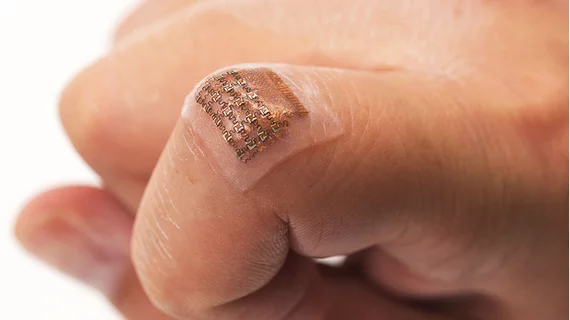A research team led by the University of California, San Diego has created a wearable ultrasound patch that can monitor central blood pressure as deep as four centimeters below the skin.
According to a press release, the patch is able to monitor the pressure in major arteries, from multiple locations on a person’s body and through fatty tissue. The patch was also made to be ultrathin and stretchable and can be used whether a patient is still or moving.
“Applications include real-time, continuous monitoring of blood pressure changes in patients with heart or lung disease, as well as patients who are critically ill or undergoing surgery,” the release said. “The patch uses ultrasound, so it could potentially be used to non-invasively track other vital signs and physiological signals from places deep inside the body.”
There aren’t many noninvasive methods for measuring central blood pressure, according to researchers. The typical technique requires having a catheter inserted into a blood vessel in a patient’s arm, groin or neck and guiding it to the heart. Physicians believe the wearable patch could be useful for inpatient procedures.
“A non-invasive method exists, but it can’t consistently produce accurate readings. It involves holding a pen-like probe, called a tonometer, on the skin directly above a major blood vessel,” the release said. “To get a good reading, the tonometer must be held steady, at just the right angle and with the right amount of pressure each time. But this can vary between tests and different technicians.”
The patch was tested on a person who wore it on their forearm, wrist, neck and foot while stationary and exercising. Researchers said recordings from the patch were “more consistent and precise” than data from a commercial tonometer and were “comparable” with data from a traditional ultrasound probe.
According to the release, the patch uses ultrasound waves to continuously record the diameter of a pulsing blood vessel below the skin. The information is then translated into a waveform which shows specific activities or events in the heart. Researchers said the “signals provided a lot of detailed information to doctors assessing a patient’s cardiovascular health” and could be used to predict heart failure.
Though they’ve seen promising results, researchers are still working to make several improvements to the patch.
“Researchers note that the patch still has a long way to go before it reaches the clinic," the release said. "Improvements include integrating a power source, data processing units and wireless communication capability into the patch."

